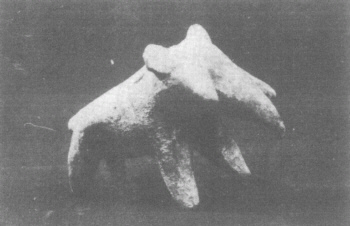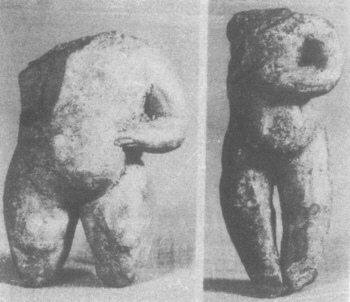Chapter 3 Section 2 Motivation for Original Sculpture Creation
The level of civilization in primitive society is not yet able to enable primitive people to make art for art's sake.Their pursuit of the perfect form of art is often related to their most basic needs, so their pursuit of beauty is the most basic and minimum requirement of human beings.In other words, the aesthetics of primitive people is a low-level aesthetics.These aesthetics can be briefly classified into the following three categories: the requirements for the minimum pleasure and entertainment; the blessing for survival; the expectation for the continuation of the species.
In primitive society sites such as the Hemudu Culture in Zhejiang, the Yangshao Culture in Gansu, and the Qujialing Culture in Hubei, some independent plastic parts with a size of a few centimeters were unearthed. As accessories; not all of them come from tombs, so they are not substitutes for some living things; if they are used as objects for a certain religious ceremony, they are too crudely made and their images are too vague.There are only two possible explanations for the appearance of these things: either the potters made some images from the remaining clay blocks and fired them together with the pottery; or they were toys made for children.Regardless of which of the above two situations, these small pottery sculptures all express primitive people's pursuit of pleasure and entertainment. (figure 2)
There are various theories about the creative purpose of primitive art, such as the theory of games (the impulse to play is the vent of human excess energy), the theory of symbols (the symbol of seasonal changes, that is, the symbol of phenology), the theory of witchcraft (compared with various related to witchcraft) and so on.If we bypass these questions about the origin of art and directly examine the expressive content of art, we can find that there are two themes that primitive art has been expressing for a long time, which are the theme of warding off evil spirits and the theme of reproduction.As a species, the first requirement is to survive and pass on, and the two most basic problems faced by primitive people are also the same.In addition to the basic food and warm body to survive, the most important thing is to avoid various disasters (such as thunder, electricity, wind, rain, water, fire, poisonous insects, beasts, diseases, etc.).In the face of various disasters, primitive people not only rely on their own strength to overcome, but also rely on some supernatural power to a large extent, which will inevitably lead to the worship of gods and elves.In art, it is all kinds of themes that avoid harm and seek good fortune. "Suzaku and Xuanwu follow the yin and yang, the blue dragon and the white tiger do not protect the sheep (Xiang)" is a formula used in the Han Dynasty to seek good luck and avoid evil.But this kind of thinking certainly did not appear in the Han Dynasty. In July 1985, a Neolithic tomb was discovered in Puyang, Henan Province. On both sides of the deceased, the images of a dragon and a tiger were piled up with mussels.The significance of this dragon and tiger is extraordinary, and it shows that this kind of thought of smoothing yin and yang and avoiding ominousness may have appeared in the Neolithic Age.Looking back, it makes sense that the aforementioned tortoise-snake pot was named Xuanwu.It seems that they are all for the same purpose of warding off evil spirits.Qinglong, Baihu, Suzaku, and Xuanwu are the four gods in the sky. Among the sculptures in primitive society, there are now three of them.

Figure 2. Neolithic Elephant Pottery Unearthed in Tianmen, Hubei
The essence of passing on is to reproduce, but primitive people do not fully understand the scientific basis of reproduction.In the eyes of primitive people, male and female copulation is certainly one of the reasons for conception, but the dominance of some mysterious force may be more important.But what this mysterious power is is covered by layers of fog, so it is unknown. From 1983 to 1985, the pottery statues and other pottery statues unearthed in Kazuo County, Jianping County and other Hongshan cultural sites in Liaoning Province are important discoveries of sculptures in the primitive period. (Figure 3) They are independent sculptures with clear sacrificial significance.The sites where these pottery sculptures were discovered were some sacrificial piles, which may have been places where primitive people sacrificed to the Mother Earth or the God of Saturn (female).The earth gives birth to all things, including the birth of human beings.The unearthed female statues with plump breasts, round belly, and wide buttocks are the same as the female bodies represented in European primitive art, and they are all images of fertile women.At the same time as the Hongshan Cultural Goddess was discovered, a group of stone statues of primitive society women were also discovered at the Taizi site in Jingoutun Town, Luanping, Hebei.The age of these stone carvings is 1,000 years earlier than the Hongshan Cultural Goddess.One of the female statues has a mutilated head, protruding breasts, huge buttocks, and open genitals, which may represent the appearance of a pregnant woman in labor.These stone carvings, pottery sculptures of female bodies, and the aforementioned pottery sculptures of man and woman combined, as well as the Taozu (male genitalia) unearthed in the Longshan Culture of Huaxian, Shaanxi and the Qujialing Culture, Tianmen, Hubei, all reflect primitive people's prayers for reproduction.

Figure 3 Nude pottery pottery unearthed in Kazuo, Inner Mongolia, Neolithic Age
In addition to these pottery sculptures with obvious meanings, are there other forms to express the prayer for reproduction and the wish to ward off evil spirits?This has to resort to more and more objects unearthed underground.Although there is no convincing real object today, such a real object will appear sooner or later.
The meaning of pottery sculpture works in primitive society is relatively vague, but their expression methods are very straightforward and simple.For example, those kneaded small animals are exaggerated, generalized, free and inadvertent, showing a kind of random beauty and childish beauty everywhere.Another example is those mimics, which boldly transform practical objects into an animal (in life or in imagination).Regardless of whether these mimics are real practical objects, their artistic effect is very strong.A typical example is the Eagle Ding of the Yangshao Culture Period unearthed in Hua County, Shaanxi Province in 1975.The front chest of the eagle is a tripod belly, which is full and strong; the feet and tail are tripod feet, strong and powerful; , sharp beak, so that the eagle looks majestic.Anyone who has seen this tripod is amazed by its extraordinary spirit.The ideology of primitive people is far from that of modern people, so the true meaning of most primitive sculptures is puzzling, but the artistic effect of primitive sculptures is strong, so primitive sculptures always carry a kind of historical mystery. It has a permanent charm because of the sense of power and the power of artistic language.

Figure 2. Neolithic Elephant Pottery Unearthed in Tianmen, Hubei

Figure 3 Nude pottery pottery unearthed in Kazuo, Inner Mongolia, Neolithic Age
